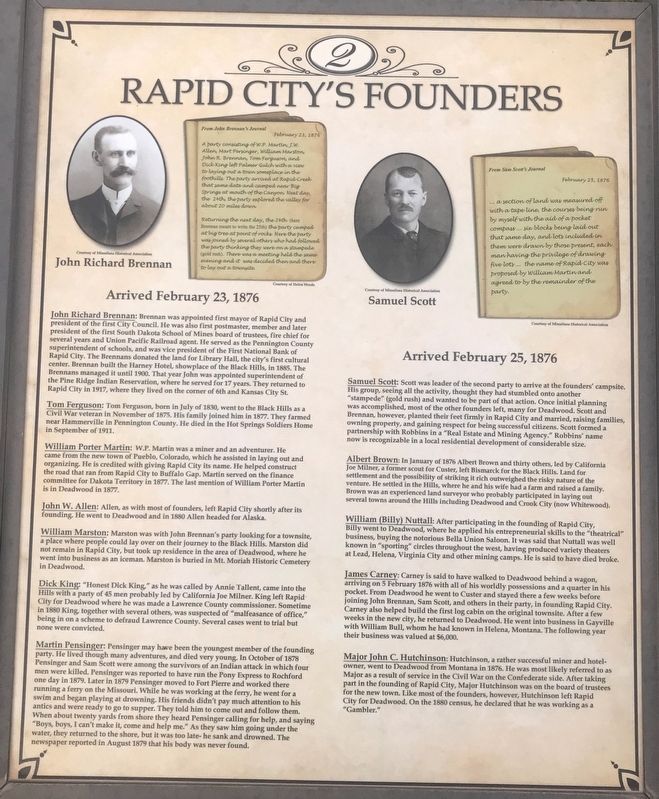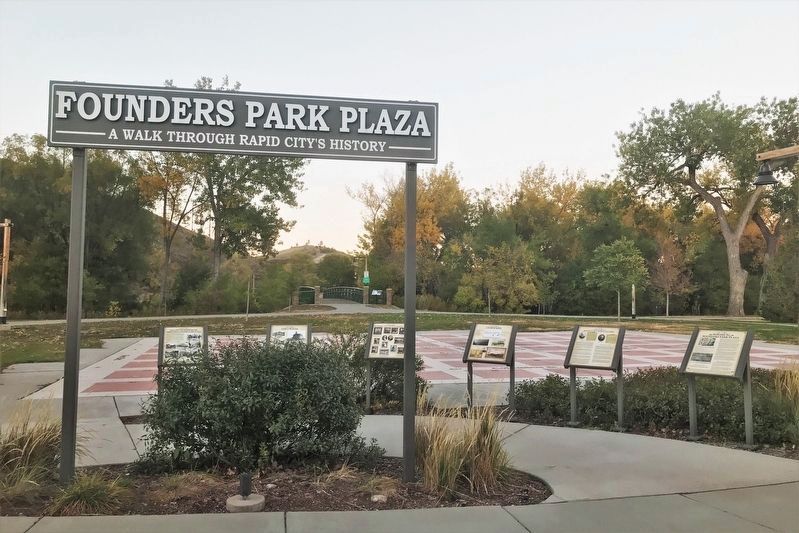Rapid City in Pennington County, South Dakota — The American Midwest (Upper Plains)
Rapid City's Founders
— Founders Park Plaza —
From John Brennan's Journal
February 23, 1876
A party consisting of W.P. Martin, J.W. Allen, Mart Persinger, William Marston, John R. Brennan, Tom Ferguson, and Dick King left Palmer Gulch with a view to laying out a town someplace in the foothills. The party arrived at Rapid Creek that same date and camped near Big Springs at mouth of the Canyon. Next day, the 24th, the party explored the valley for about 20 miles down.
Returning the next day, the 24th (here Brennan meant to write the 25th) the party camped at big tree at point of rocks. Here the party was joined by several others who had followed the party thinking they were on a stampede (gold rush). There was a meeting held the same evening and it was decided then and there to lay out a townsite.
Arrived February 23, 1876
John Richard Brennan: Brennan was appointed first mayor of Rapid City and president of the first City Council. He was also first postmaster, member and later president of the first South Dakota School of Mines board of trustees, fire chief for several years and Union Pacific Railroad agent. He served as the Pennington County superintendent of schools, and was vice president of the First National Bank of Rapid City. The Brennans donated the land for Library Hall, the city's first cultural center. Brennan built the Harney Hotel, showplace of the Black Hills, in 1885. The Brennans managed it until 1900. That year John was appointed superintendent of the Pine Ridge Indian Reservation, where he served for 17 years. They returned to Rapid City in 1917, where they lived on the corner of 6th and Kansas City St.
Tom Ferguson: Tom Ferguson, born in July of 1830, went to the Black Hills as a Civil War veteran in November of 1875. His family joined him in 1877. They farmed near Hammerville in Pennington County. He died in the Hot Springs Soldiers Home in September of 1911.
William Porter Martin: W.P. Martin was a miner and an adventurer. He came from the new town of Pueblo, Colorado, which he assisted in laying out and organizing. He is credited with giving Rapid City its name. He helped construct the road that ran from Rapid City to Buffalo Gap. Martin served on the finance committee for Dakota Territory in 1877. The last mention of William Porter Martin is in Deadwood in 1877.
John W. Allen: Allen, as with most of founders, left Rapid City shortly after its founding. He went to Deadwood and in 1880 Allen headed for Alaska.
William Marston: Marston was with John Brennan's party looking for a townsite, a place where people could lay over on their journey to the Black Hills. Marston did not remain in Rapid City, but took up residence in the area of Deadwood, where he went into business as an iceman. Marston is buried in Mt. Moriah Historic Cemetery in Deadwood.
Dick King: "Honest Dick King," as he was called by Annie Tallent, came into the Hills with a party of 45 men probably led by California Joe Milner. King left Rapid City for Deadwood where he was made a Lawrence County commissioner. Sometime in 1880 King, together with several others, was suspected of "malfeasance of office," being in on a scheme to defraud Lawrence County. Several cases went to trial but none were convicted.
Martin Pensinger: Pensinger may have been the youngest member of the founding party. He lived though many adventures, and died very young. In October of 1878 Pensinger and Sam Scott were among the survivors of an Indian attack in which four men were killed. Pensinger was reported to have run the Pony Express to Rochford one day in 1879. Later in 1879 Pensinger moved to Fort Pierre and worked there running a ferry on the Missouri. While he was working at the ferry, he went for a swim and began playing at drowning. His friends didn't pay much attention to his antics and were ready to go to supper. They told him to come out and follow them. When about twenty yards from shore they heard Pensinger calling for help, and saying "Boys, boys, I can't make it, come and help me." As they saw him going under the water, they returned to the shore, but it was too late- he sank and drowned. The newspaper reported in August 1879 that his body was never found.
Samuel Scott
From Sam Scott's Journal
February 25, 1876
... a section of land was measured off with a tape line, the courses being run by myself with the aid of a pocket compass ... six blocks being laid out that same day, and lots included in them were drawn by those present, each man having the privilege of drawing five lots ... the name of Rapid City was proposed by William Martin and agreed to by the remainder of the party.
Arrived February 25, 1876
Samuel Scott: Scott was leader of the second party to arrive at the founders' campsite. His group, seeing all the activity, thought they had stumbled onto another "stampede" (gold rush) and wanted to be part of that action. Once initial planning was accomplished, most of the other founders left, many for Deadwood. Scott and Brennan, however, planted their feet firmly in Rapid City and married, raising families, owning property, and gaining respect for being successful citizens. Scott formed a partnership with Robbins in a "Real Estate and Mining Agency." Robbins' name now is recognizable in a local residential development of considerable size.
Albert Brown: In January of 1876 Albert Brown and thirty others, led by California Joe Milner, a former scout for Custer, left Bismarck for the Black Hills. Land for settlement and the possibility of striking it rich outweighed the risky nature of the venture. He settled in the Hills, where he and his wife had a farm and raised a family. Brown was an experienced land surveyor who probably participated in laying out several towns around the Hills including Deadwood and Crook City (now Whitewood).
William (Billy) Nuttall: After participating in the founding of Rapid City, Billy went to Deadwood, where he applied his entrepreneurial skills to the "theatrical" business, buying the notorious Bella Union Saloon. It was said that Nuttall was well known in "sporting" circles throughout the west, having produced variety theaters at Lead, Helena, Virginia City and other mining camps. He is said to have died broke.
James Carney: Carney is said to have walked to Deadwood behind a wagon, arriving on 5 February 1876 with all of his worldly possessions and a quarter in his pocket. From Deadwood he went to Custer and stayed there a few weeks before joining John Brennan, Sam Scott, and others in their party, in founding Rapid City. Carney also helped build the first log cabin on the original townsite. After a few weeks in the new city, he returned to Deadwood. He went into business in Gayville with William Bull, whom he had known in Helena, Montana. The following year their business was valued at $6,000.
Major John C. Hutchinson: Hutchinson, a rather successful miner and hotel-owner, went to Deadwood from Montana in 1876. He was most likely referred to as Major as a result of service in the Civil War on the Confederate side. After taking part in the founding of Rapid City, Major Hutchinson was on the board of trustees for the new town. Like most of the founders, however, Hutchinson left Rapid City for Deadwood. On the 1880 census, he declared that he was working as a "Gambler." (Marker Number 2.)
Topics. This historical marker is listed in this topic list: Settlements & Settlers. A significant historical date for this entry is February 23, 1876.
Location. 44° 5.085′ N, 103° 14.55′ W. Marker is in Rapid City, South Dakota, in Pennington County. Located at Founders Park Plaza in Rapid City. Touch for map. Marker is at or near this postal address: 1510 W Omaha St, Rapid City SD 57701, United States of America. Touch for directions.
Other nearby markers. At least 8 other markers are within walking distance of this marker. Welcome to Founders Park Plaza (here, next to this marker); Landscapes (here, next to this marker); Pioneers and Native Americans (here, next to this marker); Early Places (here, next to this marker); Follow the Horseshoes through Founders Park Plaza (here, next to this marker); Rapid Creek Flood Mark (a few steps from this marker); Rapid Trout (a few steps from this marker); The Eagles (within shouting distance of this marker). Touch for a list and map of all markers in Rapid City.
Related markers. Click here for a list of markers that are related to this marker.
Credits. This page was last revised on December 6, 2021. It was originally submitted on October 27, 2021. This page has been viewed 339 times since then and 51 times this year. Last updated on December 6, 2021. Photos: 1, 2. submitted on October 27, 2021. • J. Makali Bruton was the editor who published this page.

